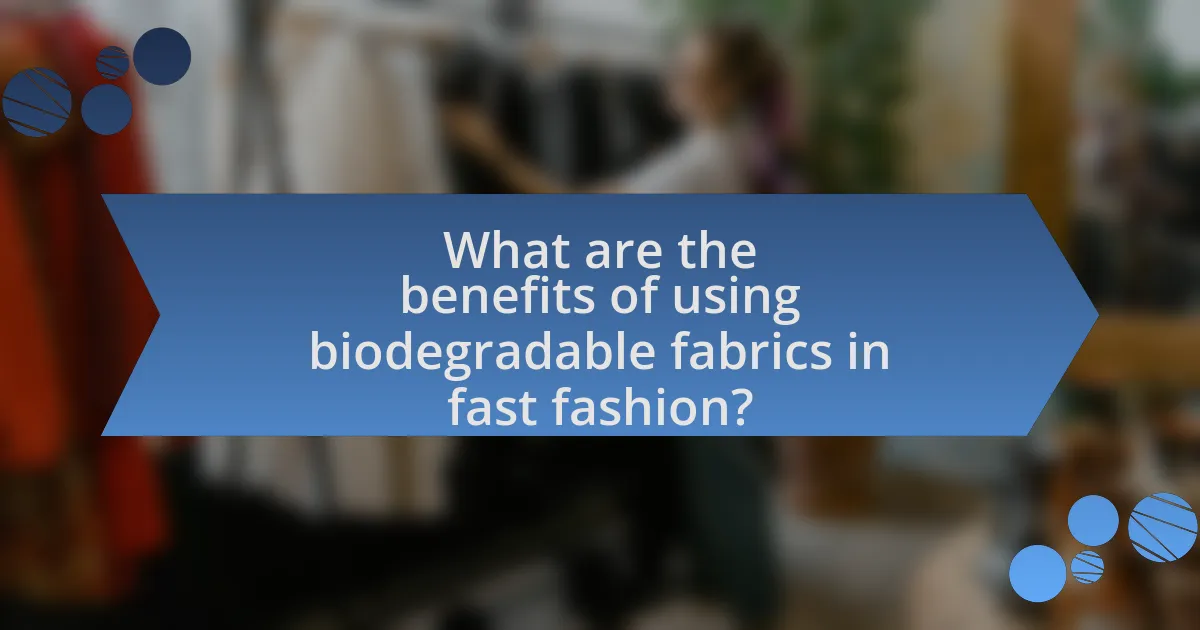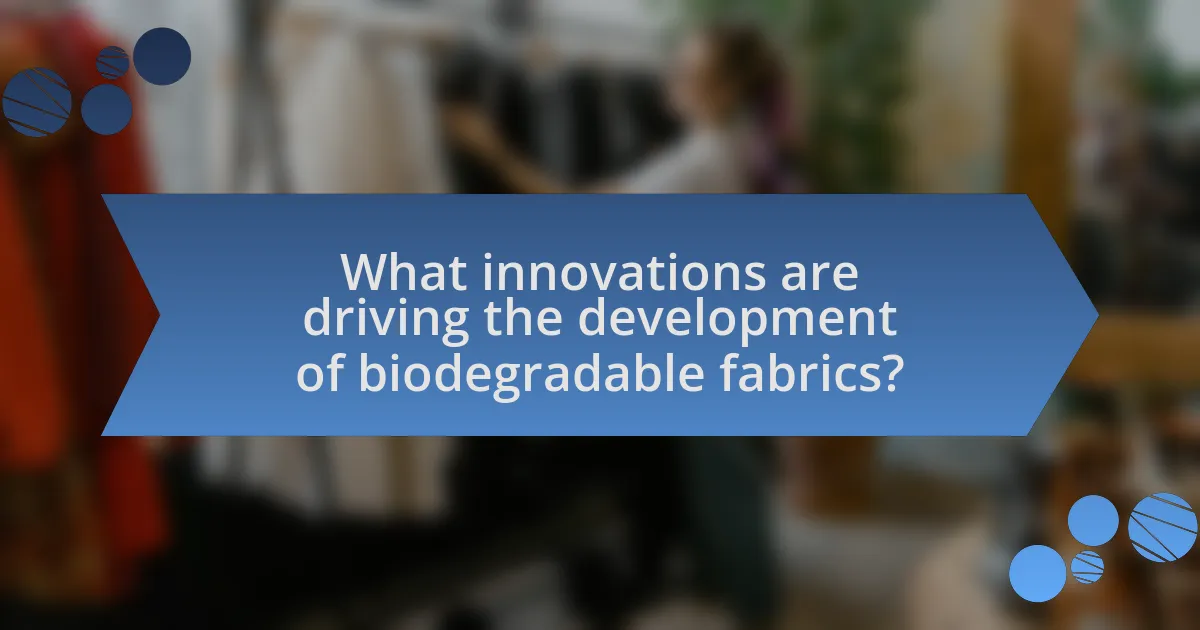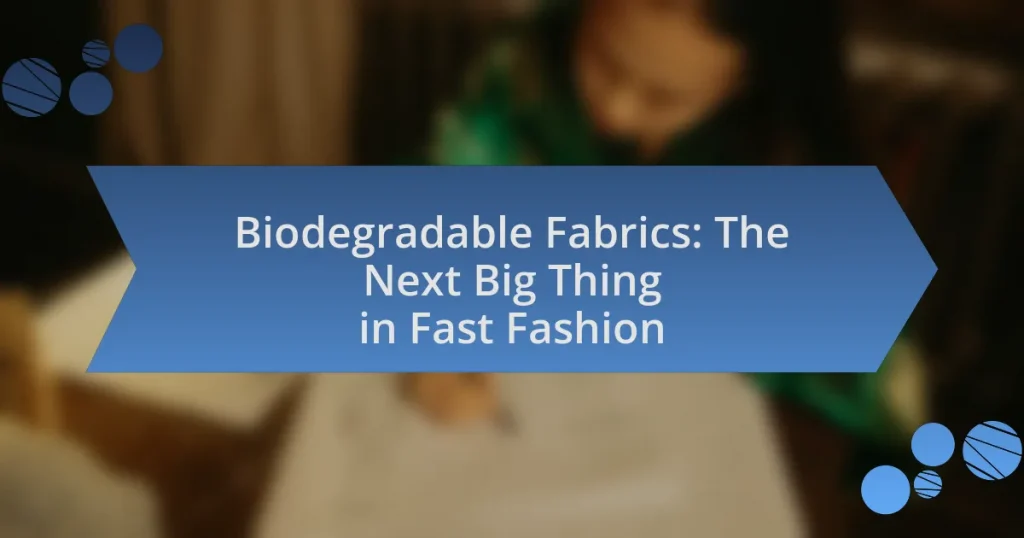Biodegradable fabrics are textiles made from natural fibers or specially designed synthetic materials that decompose over time through biological processes. This article explores the differences between biodegradable and traditional fabrics, highlighting the environmental benefits of using materials such as organic cotton, hemp, and biodegradable polymers. It discusses the production processes involved, the significance of biodegradable fabrics in the fast fashion industry, and their role in promoting sustainability. Additionally, the article addresses consumer preferences, market trends, and the challenges brands face in adopting these eco-friendly materials, while also outlining practical steps consumers can take to support biodegradable options.

What are Biodegradable Fabrics?
Biodegradable fabrics are textiles made from natural fibers or synthetic materials designed to decompose over time through biological processes. These fabrics, such as those derived from organic cotton, hemp, or biodegradable polymers like polylactic acid (PLA), break down into natural substances when exposed to environmental conditions, reducing landfill waste and environmental impact. Research indicates that biodegradable fabrics can decompose within a few months to a few years, depending on the material and conditions, contrasting with traditional fabrics that can take decades to break down.
How are biodegradable fabrics different from traditional fabrics?
Biodegradable fabrics differ from traditional fabrics primarily in their ability to decompose naturally over time. Traditional fabrics, often made from synthetic materials like polyester or nylon, can take hundreds of years to break down, contributing to environmental pollution. In contrast, biodegradable fabrics, such as those made from organic cotton, hemp, or biodegradable polymers, are designed to break down within a few months to a few years when exposed to natural environmental conditions. This characteristic significantly reduces their environmental impact, as they do not contribute to long-term waste in landfills.
What materials are commonly used to create biodegradable fabrics?
Common materials used to create biodegradable fabrics include organic cotton, hemp, linen, Tencel (lyocell), and bamboo. Organic cotton is cultivated without synthetic pesticides, making it more environmentally friendly. Hemp is known for its durability and requires less water than conventional cotton. Linen, derived from flax plants, is biodegradable and has a low environmental impact. Tencel, produced from sustainably sourced wood pulp, is fully biodegradable and compostable. Bamboo fabric is also biodegradable, as it is made from the fast-growing bamboo plant, which requires minimal resources to grow. These materials contribute to the sustainability of biodegradable fabrics in the fashion industry.
What processes are involved in the production of biodegradable fabrics?
The production of biodegradable fabrics involves several key processes, including sourcing raw materials, fiber extraction, spinning, weaving or knitting, and finishing. Sourcing raw materials typically includes natural fibers such as organic cotton, hemp, or materials derived from renewable resources like corn starch or bamboo. Fiber extraction involves processing these raw materials to obtain usable fibers, which are then spun into yarn. The yarn is subsequently woven or knitted into fabric, creating the textile structure. Finally, finishing processes may include treatments to enhance the fabric’s properties, such as dyeing or softening, while ensuring that the chemicals used are also biodegradable. These processes collectively contribute to the creation of fabrics that can decompose naturally, reducing environmental impact.
Why are biodegradable fabrics important in the context of fast fashion?
Biodegradable fabrics are important in the context of fast fashion because they significantly reduce environmental impact by decomposing naturally, unlike conventional synthetic materials that contribute to landfill waste. Fast fashion is characterized by rapid production cycles and high turnover of clothing, leading to massive textile waste; biodegradable fabrics can mitigate this issue by breaking down within a few months to a few years, thus lessening the burden on waste management systems. For instance, studies indicate that traditional polyester can take over 200 years to decompose, while biodegradable alternatives like Tencel or organic cotton can decompose in a fraction of that time, promoting a more sustainable fashion industry.
How do biodegradable fabrics contribute to sustainability in the fashion industry?
Biodegradable fabrics contribute to sustainability in the fashion industry by reducing waste and minimizing environmental impact. These materials decompose naturally, unlike conventional synthetic fabrics that can take hundreds of years to break down, leading to landfill accumulation. For instance, studies show that biodegradable textiles, such as those made from organic cotton or Tencel, can decompose within a few months under the right conditions, significantly lowering the carbon footprint associated with textile waste. This shift towards biodegradable options supports a circular economy, where materials are reused and recycled, further enhancing sustainability in fashion.
What environmental issues do biodegradable fabrics address?
Biodegradable fabrics address several critical environmental issues, primarily plastic pollution and waste management. These fabrics decompose naturally, reducing the accumulation of synthetic textiles in landfills, which can take hundreds of years to break down. For instance, traditional polyester and nylon contribute significantly to microplastic pollution in oceans, whereas biodegradable alternatives like Tencel or organic cotton break down into non-toxic components, thereby minimizing environmental harm. Additionally, the production of biodegradable fabrics often involves sustainable practices that lower carbon emissions and water usage compared to conventional fabric manufacturing, further mitigating their environmental impact.

What are the benefits of using biodegradable fabrics in fast fashion?
Biodegradable fabrics in fast fashion offer significant environmental benefits by reducing waste and pollution. These materials decompose naturally, minimizing landfill contributions and decreasing the carbon footprint associated with traditional synthetic fabrics, which can take hundreds of years to break down. For instance, a study published in the journal “Environmental Science & Technology” highlights that biodegradable textiles can reduce greenhouse gas emissions by up to 50% compared to conventional fabrics. Additionally, using biodegradable fabrics promotes sustainable practices within the fashion industry, encouraging brands to adopt eco-friendly production methods and materials. This shift not only appeals to environmentally conscious consumers but also aligns with global sustainability goals, making biodegradable fabrics a crucial component in the evolution of fast fashion.
How do biodegradable fabrics impact consumer choices?
Biodegradable fabrics significantly influence consumer choices by aligning with the growing demand for sustainable and eco-friendly products. As awareness of environmental issues increases, consumers are more inclined to purchase biodegradable fabrics, which are perceived as less harmful to the planet compared to traditional materials. A study published in the Journal of Cleaner Production found that 66% of consumers are willing to pay more for sustainable clothing options, indicating a clear preference for biodegradable alternatives. This shift in consumer behavior reflects a broader trend towards sustainability in the fashion industry, where brands that offer biodegradable options often see increased customer loyalty and market share.
What are the potential cost implications for brands using biodegradable fabrics?
Brands using biodegradable fabrics may face higher initial production costs due to the sourcing of specialized materials and the need for advanced manufacturing processes. For instance, biodegradable fabrics often require organic or sustainably sourced fibers, which can be more expensive than conventional materials. Additionally, the technology and processes involved in creating biodegradable textiles can lead to increased labor and operational costs.
Research indicates that while the upfront investment may be significant, brands could benefit from long-term savings through reduced waste management costs and potential tax incentives for sustainable practices. According to a study by the Ellen MacArthur Foundation, transitioning to sustainable materials can lead to a 20% reduction in overall costs over time due to improved resource efficiency and brand loyalty from environmentally conscious consumers.
How do biodegradable fabrics enhance brand reputation?
Biodegradable fabrics enhance brand reputation by demonstrating a commitment to sustainability and environmental responsibility. Brands that utilize biodegradable materials signal to consumers that they prioritize eco-friendly practices, which can lead to increased customer loyalty and positive brand perception. Research indicates that 66% of global consumers are willing to pay more for sustainable brands, highlighting the market demand for environmentally conscious products. By adopting biodegradable fabrics, companies not only reduce their ecological footprint but also align themselves with consumer values, ultimately strengthening their brand image in a competitive market.
What challenges do brands face when adopting biodegradable fabrics?
Brands face several challenges when adopting biodegradable fabrics, primarily related to cost, supply chain logistics, and consumer awareness. The production of biodegradable fabrics often involves higher costs compared to conventional materials, which can deter brands from making the switch. Additionally, sourcing sustainable raw materials and ensuring a reliable supply chain can complicate the transition, as many biodegradable options are not yet widely available. Furthermore, consumer awareness and demand for biodegradable products are still developing, which can impact a brand’s willingness to invest in these materials. According to a 2021 report by McKinsey & Company, only 15% of consumers are willing to pay a premium for sustainable products, highlighting the need for brands to educate their customers about the benefits of biodegradable fabrics to drive adoption.
What are the limitations of biodegradable fabrics in terms of durability?
Biodegradable fabrics often exhibit limitations in durability compared to conventional textiles. These fabrics, made from natural fibers or polymers, can degrade more quickly when exposed to environmental factors such as moisture, heat, and microbial activity. For instance, studies have shown that materials like polylactic acid (PLA) can lose structural integrity within a few months under composting conditions, which may not be suitable for long-term use in garments. Additionally, biodegradable fabrics may have lower tensile strength and abrasion resistance, making them less suitable for high-wear applications. This reduced durability can lead to shorter product lifespans, impacting their practicality in fast fashion contexts where longevity is often desired.
How can brands overcome the supply chain challenges associated with biodegradable fabrics?
Brands can overcome supply chain challenges associated with biodegradable fabrics by establishing strong partnerships with suppliers who specialize in sustainable materials. These partnerships enable brands to secure a consistent supply of high-quality biodegradable fabrics, which is crucial given the limited availability of such materials compared to conventional textiles. Additionally, brands can invest in technology that enhances the production and processing of biodegradable fabrics, thereby improving efficiency and reducing costs. For instance, advancements in biopolymer technology have led to the development of more durable and versatile biodegradable materials, making them more appealing for mass production. Furthermore, implementing transparent supply chain practices can help brands identify potential bottlenecks and address them proactively, ensuring a smoother flow of materials from production to retail.

What innovations are driving the development of biodegradable fabrics?
Innovations driving the development of biodegradable fabrics include advancements in bio-based materials, such as polylactic acid (PLA) derived from corn starch, and the use of natural fibers like hemp and organic cotton. These materials are engineered to decompose more rapidly than traditional synthetic fabrics, reducing environmental impact. Research indicates that PLA can break down in industrial composting facilities within 90 to 180 days, compared to hundreds of years for conventional plastics. Additionally, innovations in enzyme technology are enhancing the biodegradability of synthetic fibers, allowing them to decompose in natural environments.
How is technology influencing the production of biodegradable fabrics?
Technology is significantly influencing the production of biodegradable fabrics by enabling the development of innovative materials and manufacturing processes. Advances in biotechnology, such as the use of enzymes and microorganisms, allow for the creation of fabrics from natural sources like corn, sugarcane, and even waste materials, which can decompose more efficiently than traditional textiles. For instance, companies like Spinnova utilize a patented process to convert wood pulp into biodegradable fibers without harmful chemicals, demonstrating a sustainable alternative to synthetic fabrics. Additionally, 3D printing technology is being explored to produce biodegradable textiles with minimal waste, further enhancing sustainability in the fashion industry. These technological advancements not only improve the environmental impact of fabric production but also cater to the growing consumer demand for eco-friendly fashion options.
What role do research and development play in advancing biodegradable fabric technology?
Research and development are crucial in advancing biodegradable fabric technology by driving innovation in material science and production processes. R&D efforts focus on creating new biodegradable polymers and enhancing existing materials to improve their performance, durability, and environmental impact. For instance, studies have shown that the development of polylactic acid (PLA) and other bio-based fibers can significantly reduce the environmental footprint of textiles. Furthermore, R&D initiatives often involve collaboration between universities and industry, leading to breakthroughs in sustainable manufacturing techniques, such as low-energy production methods and closed-loop recycling systems. These advancements not only contribute to the feasibility of biodegradable fabrics in the fast fashion industry but also align with global sustainability goals, as evidenced by the increasing adoption of biodegradable materials in commercial applications.
How are collaborations between brands and scientists shaping the future of biodegradable fabrics?
Collaborations between brands and scientists are driving innovation in biodegradable fabrics by integrating advanced research with practical applications. These partnerships enable the development of new materials that decompose more efficiently, reducing environmental impact. For instance, brands like Stella McCartney have worked with scientists to create fabrics from mycelium, a sustainable alternative to leather, demonstrating the potential for eco-friendly textiles. Additionally, research published in the journal “Nature Sustainability” highlights how interdisciplinary collaborations can lead to breakthroughs in material science, enhancing the performance and biodegradability of textiles. Such efforts are crucial in addressing the fast fashion industry’s sustainability challenges.
What trends are emerging in the market for biodegradable fabrics?
Emerging trends in the market for biodegradable fabrics include increased consumer demand for sustainable materials, advancements in technology for fabric production, and collaborations between brands and eco-conscious organizations. Consumer awareness regarding environmental issues has led to a significant rise in the preference for biodegradable options, with a report from Grand View Research indicating that the global biodegradable fabrics market is expected to grow at a compound annual growth rate (CAGR) of 12.5% from 2021 to 2028. Additionally, innovations in materials such as Tencel and organic cotton are gaining traction, as they offer both biodegradability and performance. Brands are increasingly partnering with sustainability-focused organizations to enhance their eco-friendly credentials, further driving the adoption of biodegradable fabrics in the fast fashion industry.
How are consumer preferences shifting towards sustainable fashion options?
Consumer preferences are increasingly shifting towards sustainable fashion options due to heightened awareness of environmental issues and ethical concerns. A 2021 survey by McKinsey & Company revealed that 67% of consumers consider the use of sustainable materials as important when making fashion purchases. This shift is driven by a growing demand for transparency in supply chains and a desire to support brands that prioritize eco-friendly practices. Additionally, the rise of social media has amplified the visibility of sustainable fashion, influencing consumer choices and encouraging brands to adopt biodegradable fabrics and other sustainable practices.
What are the predictions for the future of biodegradable fabrics in fast fashion?
Predictions for the future of biodegradable fabrics in fast fashion indicate a significant shift towards sustainability, driven by consumer demand and regulatory pressures. As awareness of environmental issues grows, brands are increasingly adopting biodegradable materials to reduce waste and enhance their eco-friendly image. Research from the Ellen MacArthur Foundation highlights that transitioning to biodegradable fabrics could decrease the fashion industry’s carbon footprint by up to 30% by 2030. Additionally, advancements in technology are expected to improve the performance and affordability of these materials, making them more accessible for mass production. This trend suggests that biodegradable fabrics will become a standard in fast fashion, aligning with global sustainability goals.
What practical steps can consumers take to support biodegradable fabrics?
Consumers can support biodegradable fabrics by choosing products made from natural fibers like organic cotton, hemp, or Tencel, which are designed to decompose more easily than synthetic materials. By prioritizing purchases from brands that emphasize sustainability and transparency in their supply chains, consumers can encourage the market demand for biodegradable options. Additionally, consumers can educate themselves about the environmental impact of different fabrics and advocate for policies that promote biodegradable materials in the fashion industry. Research indicates that the global market for biodegradable textiles is expected to grow significantly, reflecting increasing consumer awareness and preference for sustainable products.
How can consumers identify brands that use biodegradable fabrics?
Consumers can identify brands that use biodegradable fabrics by looking for specific certifications and labels that indicate sustainable practices. Brands often display certifications such as Global Organic Textile Standard (GOTS) or OEKO-TEX, which ensure that materials are biodegradable and produced sustainably. Additionally, consumers can research brand transparency regarding their supply chain and material sourcing, as companies committed to biodegradable fabrics typically provide detailed information about their materials on their websites. For instance, brands like Patagonia and Eileen Fisher openly communicate their use of biodegradable materials, reinforcing their commitment to sustainability.
What are the best practices for caring for biodegradable fabrics to extend their lifespan?
To extend the lifespan of biodegradable fabrics, it is essential to wash them in cold water and avoid harsh detergents. Cold water minimizes the risk of damaging the fibers, while gentle, eco-friendly detergents prevent the breakdown of the material. Additionally, air drying instead of using a dryer helps maintain the integrity of the fabric, as high heat can accelerate degradation. Regularly storing biodegradable fabrics in a cool, dry place also protects them from moisture and pests, which can lead to deterioration. These practices are supported by studies indicating that temperature and chemical exposure significantly affect the longevity of natural fibers.















